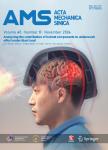Thermal-stress induced phenomena in two-component material:part I
Thermal-stress induced phenomena in two-component material:part I作者机构:Institute of Materials Research Slovak Academy of SciencesWatsonova 47 040 01 KosiceSlovak Republic
出 版 物:《Acta Mechanica Sinica》 (力学学报(英文版))
年 卷 期:2009年第25卷第6期
页 面:811-820页
核心收录:
学科分类:08[工学] 080102[工学-固体力学] 0801[工学-力学(可授工学、理学学位)]
基 金:supported by the Slovak Research and Development Agency under the contracts No. COST-0022-06, No.COST-0042-06, No. APVV-51-061505, No. APVV-0034-07, No.APVV-0171-06 by the 6th FP EU NESPA by FP7-EGPOT-2007-3 DEMATEN 204953 (05/08-04/11) by IMPROVING 229625 by HANCOC-MNT.ERA-NET 01/09-12/11 by NANOSMART Centre of Excellence (01/2007-12/2010) Slovak Academy of Sciences by the Slovak Grant Agency VEGA (2/7197/27, 2/7194/27, 2/7195/27,1/4107/07) by iNTeg-Risk CP-IP 213345-2 by European Structural Fund-Center of Excellence (Progressive Materials with Nano-and Submicron-Structure): ITMS NFP code 262200120019 by COST Action 536 by COST Action 538 by OTKA Foundation (No. T043704,T043685, T 048593, T 63609) by HPRT-CT-2000-00037 by EC5 Center of Excellence ICAI-CT-2000-70029 by OTKA Postdoctoral Research Grant (D38478) by Swedish Research Council (No. 621-2002-4299) by NSF-OTKA-MTA (No. MTA: 96 OTKA: 049953) by GVOP-3.2.1.-2004-04-0224/3.0 by Janos Bolyai Research Grant.96/OTKA 04953, OTKA 63609
主 题:Thermal stress . Limit state .Analytical modelling .Two component material
摘 要:The paper deals with analytical fracture mechanics to consider elastic thermal stresses acting in an isotropic multi-particle-matrix system. The multi-particle-matrix system consists of periodically distributed spherical particles in an infinite matrix. The thermal stresses originate during a cooling process as a consequence of the difference αm - αp in thermal expansion coefficients between the matrix and the particle, αm and αp, respectively. The multi-particle-matrix system thus represents a model system applicable to a real two-component material of a precipitation-matrix type. The infinite matrix is imaginarily divided into identical cubic cells. Each of the cubic cells with the dimension d contains a central spherical particle with the radius R, where d thus corresponds to inter-particle distance. The parameters R, d along with the particle volume fraction v = v(R, d) as a function of R, d represent microstructural characteristics of a twocomponent material. The thermal stresses are investigated within the cubic cell, and accordingly are functions of the microstructural characteristics. The analytical fracture mechanics includes an analytical analysis of the crack initiation and consequently the crack propagation both considered for the spherical particle (q = p) and the cell matrix (q = m). The analytical analysis is based on the determination of the curve integral Wcq of the thermal-stress induced elastic energy density Wq. The crack initiation is represented by the determination of the critical particle radius Rqc = Rqc(V). Formulae for Rqc are valid for any two-component mate- rial of a precipitate-matrix type. The crack propagation for R 〉 Rqc is represented by the determination of the function fq describing a shape of the crack in a plane perpendicular



